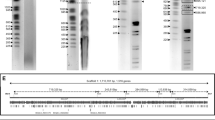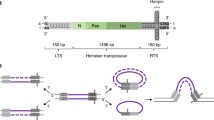Abstract
Plasmids containing two inverted 0.6-kb stretches of human telomeric repeats transform Aspergillus nidulans at frequencies characteristic of autonomously replicating vectors. Transformation frequency is not affected when the plasmids are linearized in vitro prior to transformation by cutting between the inverted repeats. Southern analysis reveals the presence of a homogeneous pool of linear plasmid molecules in mycelium of transformants. Addition of the AMA1 plasmid replicator to the telomere-containing plasmids has only a minor effect on transformation. The phenotypic stability of the transformants is low. However, unlike conventional replicative transformants containing AMA1-bearing plasmids, these transformants are prone to spontaneous stabilization which occurs predominantly by conversion of the mutant chromosomal allele of the marker gene to the plasmid-borne allele. The data strongly suggest that telomeric DNA can act as a plasmid replicator. An alternative interpretation is that autonomous replication of linear DNA fragments, in contrast to covalently closed supercoiled molecules, does not require any special replicator sequences.
Similar content being viewed by others
Author information
Authors and Affiliations
Additional information
Received: 13 January 1998 / Accepted: 10 June 1998
Rights and permissions
About this article
Cite this article
Aleksenko, A., Ivanova, L. In vivo linearization and autonomous replication of plasmids containing human telomeric DNA in Aspergillus nidulans . Mol Gen Genet 260, 159–164 (1998). https://doi.org/10.1007/s004380050881
Issue Date:
DOI: https://doi.org/10.1007/s004380050881




